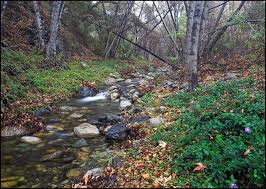Location: Orange County
Project Type: Restoration Planning
Status: Current
Cost: $45,000,000
Funding Gap: $21,000,000
Area Affected: 25 acres
Project Footprint: 0.5 stream miles
Assembly District: 73
Senate District: 36
Congressional District: 49
Project Lead/Grantee:
California Trout, Sandra Jacobson
 For more information, visit scwrp.org
For more information, visit scwrp.org
This fish passage project at the Interstate 5 bridge array and Metrolink Railroad Bridge crossing on Trabuco Creek addresses some of the most significant fish passage barriers in Southern California. Trabuco Creek is in the San Juan Creek watershed in Orange County, a high priority steelhead recovery river identified in the National Marine Fisheries Services Southern California Steelhead Recovery Plan (2012). The two barriers to fish passage at the I-5 and Metrolink crossings are coordinately being remediated due to their proximity.
The project, led by California Trout and the Design/Permitting Team of NHC, Mike Love & Assoc, and Gannett Fleming, features complex technical design and large-scale construction that will a) remediate two adjacent barriers located about 0.5 miles apart in lower Trabuco Creek, b) provide steelhead passage through these barriers beneath the Metrolink railroad bridge and the I-5 bridge array, c) restore the 1/2 mile stretch of stream channel between the two structures, and d) improve infrastructure at the project site and provide access to historic spawning and rearing habitat 12 miles upstream. This project leverages upstream removal of >81 check dams in Trabuco and San Juan Creek by the Forest Service to improve habitat accessibility of native aquatic species. See a 2023 posting of the 3D renderings and animation of the fish passage solutions, and an article in The Osprey that describes the multi-stakeholder approach to endangered species management, transportation and flood conveyance infrastructure improvement and coastal resiliency planning.
The project is in final design phase. The next steps are finalizing engineering plans and permits, generating bid-ready documents, agency-approved construction permits and then phased construction. Fish passage design has been funded by California Department of Fish and Wildlife, National Fish and Wildlife Foundation, and Wildlife Conservation Board. Funding has been secured from NOAA and CDFW for construction of the Metrolink fish passage structure and upstream intervening stream reach restoration. Construction start is anticipated to be March 2026.

